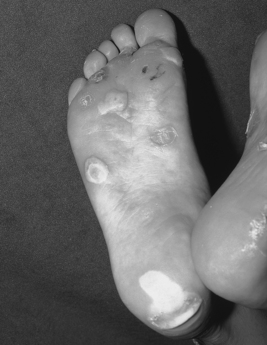30. Epidermolysis Bullosa
Definition
Epidermolysis bullosa (EB) is a group of disorders that give rise to blister formation secondary to even the most minor mechanical trauma.
Incidence
In the United States the incidence of EB is about 50:1,000,000 live births. Internationally it varies according to country, e.g., Norway: 54:1,000,000; Japan: 7.8:1,000,000; Croatia: 9.6:1,000,000.
Etiology
The skin and oral mucosa are composed of several stratified squamous epithelial tissues that contain a basement membrane zone (BMZ). The BMZ itself is composed of specialized components. These components combine to make various complexes that anchor the BMZ. EB results from inherited defects in the BMZ and/or anchoring complexes, depending on the variant of EB.
Signs and Symptoms
• Anal stenosis
• Blisters (conjunctival, oral, genital mucosa)
• Corneal scarring
• Esophageal strictures and webs
• Flexion contractures
• Hyperhidrosis
• Palmoplantar hyperkeratosis
• Phimosis
• Scar-like papules on the trunk
• Urethral stenosis
 |
| Epidermolysis Bullosa. Epidermolysis bullosa simplex, Weber-Cockayne type. |
Medical Management
The chief concerns with EB are infection and wound healing. Large bullae can form from relatively minor trauma, producing large areas of denuded skin. These areas are generally moist and rich with substrate supportive of bacterial growth. The patient with EB is more susceptible to sepsis as a result.

Full access? Get Clinical Tree




